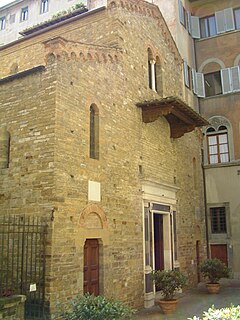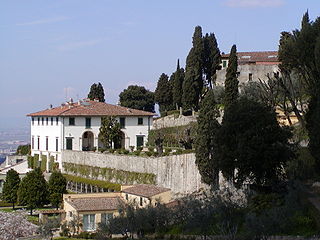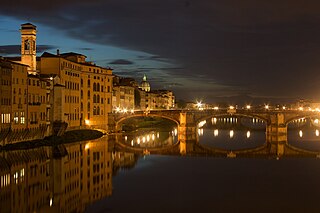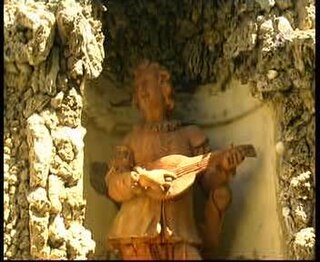Related Research Articles

Bartolomeo Ammannati was an Italian architect and sculptor, born at Settignano, near Florence. He studied under Baccio Bandinelli and Jacopo Sansovino and closely imitated the style of Michelangelo.

The Boboli Gardens is a historical park of the city of Florence that was opened to the public in 1766. Originally designed for the Medici, it represents one of the first and most important examples of the Italian garden, which later served as inspiration for many European courts. The large green area is a real open-air museum with statues of various styles and periods, ancient and Renaissance that are distributed throughout the garden. It also has large fountains and caves, among them the splendid Buontalenti grotto built by the artist, architect and sculptor Bernardo Buontalenti between 1536 and 1608.

The Accademia di Belle Arti di Firenze is an instructional art academy in Florence, in Tuscany, in central Italy.

The Villa Giulia is a villa in Rome, Italy. It was built by Pope Julius III in 1551–1553 on what was then the edge of the city. Today it is publicly owned, and houses the Museo Nazionale Etrusco, a collection of Etruscan art and artifacts.

The Province of Lucca is a province in the Tuscany region of Italy. Its capital is the city of Lucca.

The Church of Santi Apostoli is a Romanesque-style, Roman Catholic church in the historic center of Florence, in the Tuscany region of Italy. It is among the oldest church buildings in Florence.

Settignano is a frazione on a hillside northeast of Florence, Italy, with views that have attracted American expatriates for generations. The little borgo of Settignano carries a familiar name for having produced three sculptors of the Florentine Renaissance, Desiderio da Settignano and the Gamberini brothers, better known as Bernardo Rossellino and Antonio Rossellino. The young Michelangelo lived with a sculptor and his wife in Settignano—in a farmhouse that is now the "Villa Michelangelo"— where his father owned a marble quarry. In 1511 another sculptor was born there, Bartolomeo Ammannati. The marble quarries of Settignano produced this series of sculptors.

The Villa Medici is a patrician villa in Fiesole, Tuscany, Italy, the fourth oldest of the villas built for the Medici family. It was built between 1451 and 1457. It is part of the UNESCO World Heritage Site inscribed as Medici Villas and Gardens in Tuscany.

Castelnuovo Berardenga is a comune (municipality) in the province of Siena in the Italian region Tuscany, located about 50 kilometres (31 mi) southeast of Florence and about 14 kilometres (9 mi) east of Siena. Since 1932 it is included in the Chianti wine-production area.

The Villa Medici at Careggi is a patrician villa in the hills near Florence, Tuscany, central Italy.

The Ponte Santa Trìnita is a Renaissance bridge in Florence, Italy, spanning the Arno. The Ponte Santa Trìnita is the oldest elliptic arch bridge in the world, characterised by three flattened ellipses. The outside spans each measure 29 m (95 ft) with the centre span being 32 m (105 ft) in length. The two neighbouring bridges are the Ponte Vecchio, to the east, and the Ponte alla Carraia to the west.

Giulio Parigi (1571–1635) was an Italian architect and designer.

The Villa Marlia or Villa Reale di Marlia — a late-renaissance palazzo or villa, and its estate's property that includes renowned gardens and adjacent villas and follies within the compound. It is located in Capannori, in the Province of Lucca, west of Florence, in the northern Tuscany region of Italy.

The Villa di Castello, near the hills bordering Florence, Tuscany, central Italy, was the country residence of Cosimo I de' Medici, Grand Duke of Tuscany (1519-1574). The gardens, filled with fountains, statuary, and a grotto, became famous throughout Europe. The villa also housed some of the great art treasures of Florence, including Sandro Botticelli's Renaissance masterpieces The Birth of Venus and Primavera. The gardens of the Villa had a profound influence upon the design of the Italian Renaissance garden and the later French formal garden.

The Villa del Trebbio is a Medici villa in Tuscany, Italy.

Villa Gamberaia is a seventeenth-century villa near Settignano, outside Florence, Tuscany, Italy.

The Ducal Palace is a palace in Lucca, Tuscany, central Italy.

The Casino Mediceo di San Marco is a late-Renaissance or Mannerist style palace located on Via Cavour number 57 and via San Gallo in Florence, region of Tuscany, Italy.

The Conservatorio Luigi Cherubini is located in piazza delle Belle Arti in Florence. The conservatory, among the most important in Italy, is named after the Florentine composer Luigi Cherubini (1760–1842).

The name of Villa Balestra indicates today the homonymous urban park in Rome (Italy), located on the top of the tufaceous hill overlooking Viale Tiziano. The garden occupies the extreme offshoot of the Monti Parioli, though it belongs to the Quarter Pinciano, together with Via Bartolomeo Ammannati from which it is accessed.
References
- ↑ "The Garden". Villa Varramista.CS1 maint: discouraged parameter (link)
- ↑ "Tuscany: Varramista's century-long history". Villa Varramista. Archived from the original on 2010-07-15.